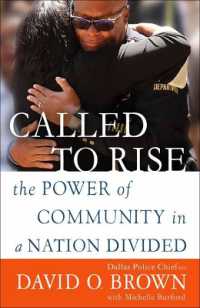Full Description
Examines strategies and best practices that effectively integrate LGBTQ areas of teaching and research with student life activities.
Many educational professionals agree that the time has come to expand their circle of inclusion and broaden their definition of diversity by increasing LGBTQ studies, but the question of how to do so is still debated. Although some colleges and universities have been incorporating LGBTQ studies for decades, courses and programs continue to be pockets of innovation rather than models of inclusion for all of higher education. Colleges and universities need to encourage faculty members to teach and research a wide range of LGBTQ topics, as well as support student life professionals in building inclusive campus communities. This book includes testimonies that alert educators to possible pitfalls and successes of their policies through an analysis of changing student attitudes. Based on these case studies, the contributors offer practical suggestions for the classroom and the provost's office, demonstrating not only the gains that have been made by LGBTQ students and the institutions that serve them, but also the tensions that remain.
Contents
List of Illustrations
Acknowledgments
Introduction: Building on a Changing Paradigm
John C. Hawley
Part I. Changing Institutional Structures
1. A Website Evaluation of the Top Twenty-Five Public Universities in the United States to Assess Their Support of Lesbian, Gay, Bisexual, and Transgender People
Bharat Mehra, Donna Braquet, and Calle M. Fielden
2. Conducted in a Whisper: Some Observations About the Current State of LGBT Studies, and Ten Ways We Can Shout Down the Silence
Joshua G. Adair
3. Queering the Academy: A Case Approach to LGBTQ Studies
Molly Merryman and K. G. Valente
4. Transgendering the Academy: Transforming the Relationship Between Theory and Praxis
Pauline Park
Part II. Case Studies
5. Creating Systemic Change Around Lesbian, Gay, Bisexual, and Transgender (LGBT) Issues: A Case Analysis and Recommendations
Frank D. Golom
6. Network VA: A Case Study of a Statewide Effort to Build LGBTQ Coalitions for Change on College Campuses
Charles H. Ford and Elizabeth P. Cramer
7. The One-Year Campus-Climate Turnaround: The University of Rhode Island Strives to Become a Leader in LGBTQ Advocacy
Karen de Bruin
8. Queering Harvard Yard: Four Decades of Progress for BGLTQ Equality
Susan B. Marine, Paul J. McLoughlin II, and Timothy Patrick McCarthy
Part III. Changing Student Perceptions
9. Student Development: Theory to Practice in LGBT Campus Work
Milton E. Ford, Colette Seguin Beighley, and Ronni Sanlo
10. Queering Service Learning: Promoting Antioppressive Action and Reflection by Undoing Dichotomous Thinking
David M. Donahue and Myles Luber
11. Five Proposals on Homophobia
David William Foster
12. LGBT Bullying in Schools: Can School Policies Affect Climate?
Erik Green
13. Exploring the Boundaries of Self: Using Queer Autobiography to Teach Courses on Identity and Solidarity Across Borders
Juan Velasco
Part IV. Expanding the Circle
14. Show Me Your ID
Jewelle Gomez
15. At the Crossroads: Navigating the Intersection of Spiritual and Sexual Identity Within Lesbian, Gay, Bisexual, Transgender, and Queer (LGBTQ) College Students
Beth Bradley and Brian J. Patchcoski
16. New Perspectives on Religion and Spirituality for LGBTQ Students
Scotty McLennan
17. Intersections: A Guide to Working with LGBTQI University Students of Minority Religions or Cultures
Mychal Copeland and D'vorah Rose
18. Culturally Appropriate Information Supposrt Services for Lesbian, Gay, Bisexual, and Transgender (LGBT) South Asians: Representing Multiple Shades of Identity Based on Sexual Orientation and Ethnicity
Bharat Mehra, Eric Haley, and Dylan Lane
Contributors
Index








